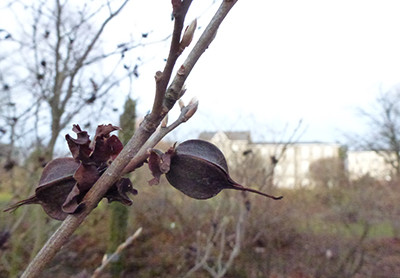
Plants of the Week: January 2
Winter is a great time of year to appreciate how this Stewartia earned its specific epithet. The species name rostrata comes from the Latin meaning “beaked” or “hooked,” referring to the ½” long beak-like protrusions that develop at the ends of the seed capsules, giving them a unique “bird’s-head” appearance. Generally a medium-sized tree growing to 20 to 30 feet tall, Stewartia is in the tea family Theaceae and is closely related to Camellia. This particular species, originally from China, blooms bright-white in May-June, after it drops its petals it begins forming the unique seed pods. A ten-year old specimen can be found growing happily next to the Dean Bond Rose Garden. photo credit: J. Bickel
Ilex aquifolium ‘Ferox Argentea’
Commonly called the silver hedgehog holly, ‘Ferox Argentea’ is a peculiar cultivated variety of the common species Ilex aquifolium. Generally growing to a large, bushy, evergreen tree, the leaves of ‘Ferox Argentea’ feature cream colored marginal variegation and spines that grow from both the leaf margins and axial leaf surfaces giving them a particularly wicked appearance. Adding to the ornamental value are maroon colored young stems and reddish-purple flower buds that open to small white flowers. With the species generally being dioecious and the cultivar being cloned from a male individual, no fruit will appear on this particular plant. A very small, newly planted specimen can be found at the top of the hill at the northwest corner of the Holly Collection. photo credit: J. Bickel
Ilex x attenuata ‘Hume #2’
Ilex x attenuata is a naturally occurring interspecific hybrid resulting from crosses between Ilex opaca and Ilex cassine. ‘Hume #2’ and the other four members of the same breeding program are now all called by the cultivar name ‘Fosteri’ or more colloquially Foster hollies. Sources say that Foster hollies are the result of breeding work done by E. E. Foster of Alabama in the 1950s. Generally dioecious, Foster hollies are peculiar in their ability to produce mature berries without fertilization from a male specimen. Leaves are entire with marginal spines, while the fruit is bright red, globose, and plentiful. This specimen can be found in the middle of the Holly Collection. photo credit: J. Bickel








No Comments